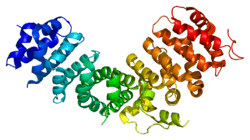Plakophilin-1
Plakophilin-1 is a protein that in humans is encoded by the PKP1 gene.[5][6]
Function
This gene encodes a member of the arm-repeat (armadillo) and plakophilin gene families. Plakophilin proteins contain numerous armadillo repeats, localize to cell desmosomes and nuclei, and participate in linking cadherins to intermediate filaments in the cytoskeleton. This protein may be involved in molecular recruitment and stabilization during desmosome formation. Mutations in this gene have been associated with the ectodermal dysplasia/skin fragility syndrome.[6]
Interactions
PKP1 has been shown to interact with Desmoplakin.[7]
gollark: 233 bytes seems implausible for the entire thing, and my browser identifies it a "detached OpenPGP signature (233 bytes)".
gollark: Are you sure file.lua.gpg isn't a *signature*, by the way?
gollark: Oh yes, fair.
gollark: Decompiled, but better.
gollark: The prime factorization is not designed to be very challenging and was indeed reduced in difficulty some months ago.
See also
References
- GRCh38: Ensembl release 89: ENSG00000081277 - Ensembl, May 2017
- GRCm38: Ensembl release 89: ENSMUSG00000026413 - Ensembl, May 2017
- "Human PubMed Reference:". National Center for Biotechnology Information, U.S. National Library of Medicine.
- "Mouse PubMed Reference:". National Center for Biotechnology Information, U.S. National Library of Medicine.
- Cowley CM, Simrak D, Spurr NK, Arnemann J, Buxton RS (September 1997). "The plakophilin 1 (PKP1) and plakoglobin (JUP) genes map to human chromosomes 1q and 17, respectively". Hum Genet. 100 (3–4): 486–8. doi:10.1007/s004390050539. PMID 9272178.
- "Entrez Gene: PKP1 plakophilin 1 (ectodermal dysplasia/skin fragility syndrome)".
- Hofmann I, Mertens C, Brettel M, Nimmrich V, Schnölzer M, Herrmann H (July 2000). "Interaction of plakophilins with desmoplakin and intermediate filament proteins: an in vitro analysis". J. Cell Sci. 113. ( Pt 13): 2471–83. PMID 10852826.
Further reading
- Hatzfeld M, Kristjansson GI, Plessmann U, Weber K (1995). "Band 6 protein, a major constituent of desmosomes from stratified epithelia, is a novel member of the armadillo multigene family". J. Cell Sci. 107. ( Pt 8): 2259–70. PMID 7527055.
- Heid HW, Schmidt A, Zimbelmann R, Schäfer S, Winter-Simanowski S, Stumpp S, Keith M, Figge U, Schnölzer M, Franke WW (1995). "Cell type-specific desmosomal plaque proteins of the plakoglobin family: plakophilin 1 (band 6 protein)". Differentiation. 58 (2): 113–31. doi:10.1046/j.1432-0436.1995.5820113.x. PMID 7890138.
- McGrath JA, McMillan JR, Shemanko CS, Runswick SK, Leigh IM, Lane EB, Garrod DR, Eady RA (1997). "Mutations in the plakophilin 1 gene result in ectodermal dysplasia/skin fragility syndrome". Nat. Genet. 17 (2): 240–4. doi:10.1038/ng1097-240. PMID 9326952.
- Schmidt A, Langbein L, Rode M, Prätzel S, Zimbelmann R, Franke WW (1998). "Plakophilins 1a and 1b: widespread nuclear proteins recruited in specific epithelial cells as desmosomal plaque components". Cell Tissue Res. 290 (3): 481–99. doi:10.1007/s004410050956. PMID 9369526.
- Smith EA, Fuchs E (1998). "Defining the interactions between intermediate filaments and desmosomes". J. Cell Biol. 141 (5): 1229–41. doi:10.1083/jcb.141.5.1229. PMC 2137181. PMID 9606214.
- Bonné S, van Hengel J, van Roy F (1998). "Chromosomal mapping of human armadillo genes belonging to the p120(ctn)/plakophilin subfamily". Genomics. 51 (3): 452–4. doi:10.1006/geno.1998.5398. PMID 9721216.
- Schmidt A, Langbein L, Prätzel S, Rode M, Rackwitz HR, Franke WW (1999). "Plakophilin 3--a novel cell-type-specific desmosomal plaque protein". Differentiation. 64 (5): 291–306. doi:10.1046/j.1432-0436.1999.6450291.x. PMID 10374265.
- Hofmann I, Mertens C, Brettel M, Nimmrich V, Schnölzer M, Herrmann H (2000). "Interaction of plakophilins with desmoplakin and intermediate filament proteins: an in vitro analysis". J. Cell Sci. 113. ( Pt 13): 2471–83. PMID 10852826.
- Hofmann I, Mücke N, Reed J, Herrmann H, Langowski J (2000). "Physical characterization of plakophilin 1 reconstituted with and without zinc". Eur. J. Biochem. 267 (14): 4381–9. doi:10.1046/j.1432-1327.2000.01483.x. PMID 10880961.
- Whittock NV, Haftek M, Angoulvant N, Wolf F, Perrot H, Eady RA, McGrath JA (2000). "Genomic amplification of the human plakophilin 1 gene and detection of a new mutation in ectodermal dysplasia/skin fragility syndrome". J. Invest. Dermatol. 115 (3): 368–74. doi:10.1046/j.1523-1747.2000.00082.x. PMID 10951270.
- Chen X, Bonne S, Hatzfeld M, van Roy F, Green KJ (2002). "Protein binding and functional characterization of plakophilin 2. Evidence for its diverse roles in desmosomes and beta -catenin signaling". J. Biol. Chem. 277 (12): 10512–22. doi:10.1074/jbc.M108765200. PMID 11790773.
- Hamada T, South AP, Mitsuhashi Y, Kinebuchi T, Bleck O, Ashton GH, Hozumi Y, Suzuki T, Hashimoto T, Eady RA, McGrath JA (2002). "Genotype-phenotype correlation in skin fragility-ectodermal dysplasia syndrome resulting from mutations in plakophilin 1". Exp. Dermatol. 11 (2): 107–14. doi:10.1034/j.1600-0625.2002.110202.x. PMID 11994137.
- McMillan JR, Haftek M, Akiyama M, South AP, Perrot H, McGrath JA, Eady RA, Shimizu H (2003). "Alterations in desmosome size and number coincide with the loss of keratinocyte cohesion in skin with homozygous and heterozygous defects in the desmosomal protein plakophilin 1". J. Invest. Dermatol. 121 (1): 96–103. doi:10.1046/j.1523-1747.2003.12324.x. PMID 12839569.
- South AP, Wan H, Stone MG, Dopping-Hepenstal PJ, Purkis PE, Marshall JF, Leigh IM, Eady RA, Hart IR, McGrath JA (2004). "Lack of plakophilin 1 increases keratinocyte migration and reduces desmosome stability". J. Cell Sci. 116 (Pt 16): 3303–14. doi:10.1242/jcs.00636. PMID 12840072.
- Cheng X, Mihindukulasuriya K, Den Z, Kowalczyk AP, Calkins CC, Ishiko A, Shimizu A, Koch PJ (2004). "Assessment of splice variant-specific functions of desmocollin 1 in the skin". Mol. Cell. Biol. 24 (1): 154–63. doi:10.1128/MCB.24.1.154-163.2004. PMC 303333. PMID 14673151.
- Choi HJ, Weis WI (2005). "Structure of the armadillo repeat domain of plakophilin 1". J. Mol. Biol. 346 (1): 367–76. doi:10.1016/j.jmb.2004.11.048. PMID 15663951.
- Wahl JK (2005). "A role for plakophilin-1 in the initiation of desmosome assembly". J. Cell. Biochem. 96 (2): 390–403. doi:10.1002/jcb.20514. PMID 15988759.
- Zheng R, Bu DF, Zhu XJ (2006). "Compound heterozygosity for new splice site mutations in the plakophilin 1 gene (PKP1) in a Chinese case of ectodermal dysplasia-skin fragility syndrome". Acta Derm. Venereol. 85 (5): 394–9. doi:10.1080/00015550510037684. PMID 16159729.
This article is issued from Wikipedia. The text is licensed under Creative Commons - Attribution - Sharealike. Additional terms may apply for the media files.





